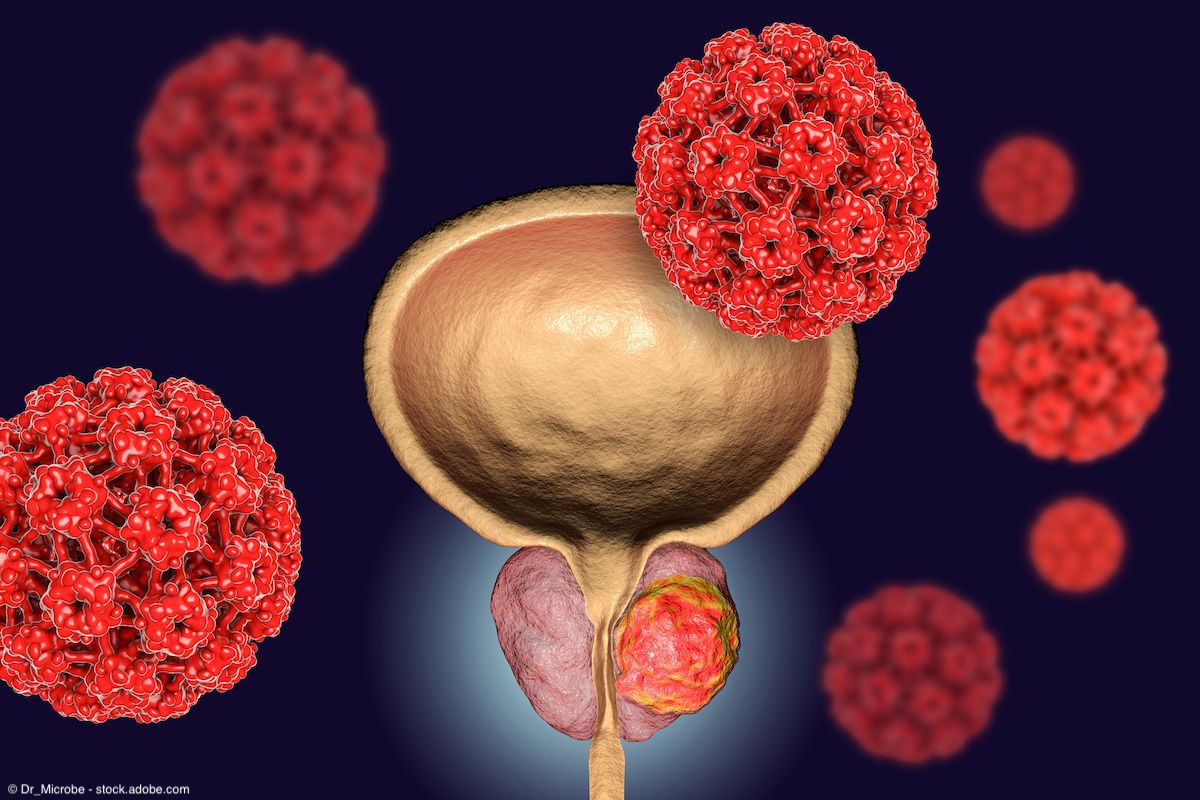Article
FDA approves talazoparib plus enzalutamide for HRR gene–mutated mCRPC
Author(s):
The approval is based on findings from the phase 3 TALAPRO-2 trial.
The FDA has approved the combination of talazoparib (Talzenna) and enzalutamide (Xtandi) for the treatment of patients with homologous recombination repair (HRR) gene-mutated metastatic castration-resistant prostate cancer (mCRPC).1
“The FDA’s approval of the talazoparib and enzalutamide combination is based on the findings from the pivotal TALAPRO-2 study, which demonstrated statistically significant and clinically meaningful reductions in the risk of progression or death among HRR gene-mutated tumors in patients with metastatic castration-resistant prostate cancer. It represents a treatment option deserving of excitement and attention,” said Neeraj Agarwal, MD, global lead investigator for TALAPRO-2.

The approval is based on findings from the phase 3 TALAPRO-2 trial, in which the combination reduced the risk of disease progression or death by 55% vs enzalutamide alone in a subgroup of patients with HRR gene–altered mCRPC.2,3 The median radiographic progression-free survival (rPFS) was not yet reached (95% CI, 21.9-NR) in patients receiving talazoparib/enzalutamide (n = 200) vs 13.8 months (95% CI, 11.0-16.7) in the control arm (HR, 0.45; 95% CI, 0.33-0.61; P <.0001).
The rPFS benefit extended to all subgroups of HRR deficient patients, including those with BRCA1/2 mutations. In the BRCA mutation–positive group, the talazoparib combination led to an 80% reduction in the risk of disease progression or death versus the control arm (HR, 0.20; 95% CI, 0.11-0.36, P <.0001). Among patients without BRCA1/2 mutations, there was a much smaller rPFS benefit observed in the talazoparib arm (HR, 0.72; 95% CI, 0.49-1.07; P = 0.10).
“Despite treatment advancement in metastatic castration-resistant prostate cancer, the disease can progress quickly, and many patients may only receive one line of therapy. Therefore, new first-line treatment options are needed to reduce the risk of disease progression or death. For patients with mCRPC harboring HRR genetic alterations, outcomes are even worse,” Neeraj Agarwal, MD, FASCO, professor and Presidential Endowed Chair of Cancer Research at Huntsman Cancer Institute, University of Utah, and global lead investigator for TALAPRO-2, stated in a press release.1
“The FDA’s approval of the talazoparib and enzalutamide combination is based on the findings from the pivotal TALAPRO-2 study, which demonstrated statistically significant and clinically meaningful reductions in the risk of progression or death among HRR gene-mutated tumors in patients with metastatic castration-resistant prostate cancer. It represents a treatment option deserving of excitement and attention,” added Agarwal.1
The overall phase 3 TALAPRO-2 study examined the combination of the PARP inhibitor talazoparib and the androgen receptor enzalutamide vs placebo plus enzalutamide in an all-comer population of 805 patients receiving first-line treatment for mCRPC.2,3
At baseline, those with a BRCA2 alteration in their disease made up 31% of patients in the talazoparib arm compared with 36.7% in the placebo arm, whereas patients with a BRCA1 alteration made up 5.5% and 6%, respectively. HRR deficient patients with only a BRCA2 alteration (n = 55) in the combination arm had a significant rPFS compared to the BRCA2 patients (n = 60) on the placebo arm (HR, 0.19; 95% CI, 0.10-0.38, P <.0001). Similar results were seen with patients who had only a BRCA1 alteration (HR, 0.17; 95% CI, 0.02-1.51, P = 0.074) and significant rPFS benefit was seen in patients with a BRCA cluster in their disease (HR, 0.20; 95% CI, 0.11-0.36, P <.0001).
Patients given prior abiraterone or docetaxel made up 37.5% of patients in the combination arm compared with a similar rate in the placebo arm at 37.2%. More patients in the combination arm and placebo arm had just docetaxel vs abiraterone at 8% vs 30.2% and 8% vs 28.5%, respectively. Overall, most patients disease was in the bone in both arms at 87.5% in the talazoparib arm and 79.4% in the placebo arm, with a similar median range of prostate specific antigen (PSA) at 19.6 ng/mL (range, 0.2-3412.0) in the talazoparib arm compared with 18.0 ng/mL (range, 0.0-1055.0) in the placebo and enzalutamide arm.
An objective response rate (ORR) of 67.1% was seen in the combination arm with 38.4% of those responses being complete responses and a stable disease rate of 26% was observed, while 5.6% of remaining patients on the combination arm had progressive disease. In comparison, the ORR was 40% in the placebo arm with 18.5% of those responses being complete, 32.3% had stable disease and 20% had progressive disease.
no new safety signals were identified with the combination regimen, but grade 3-4 treatment emergent adverse effects (TEAEs) made were seen in 66.2% of patients on the combination therapy vs 37.2% of those on the placebo and enzalutamide treatment. Dose interruption of talazoparib due to an AE was seen in 67.2% of patients compared with 19.6% of those on the placebo arm and just over half of patients (55.6%) in the combination arm had to dose reduce their talazoparib.
Still, discontinuation rates were low in the combination arm at 10.1% compared with 7% in the placebo arm, and AEs of interest with talazoparib remained low with no reported cases of myelodysplastic syndrome or acute myeloid leukemia. The use of talazoparib and enzalutamide prolonged the time to a clinically meaningful deterioration of quality of life at a median of 27.1 months (95% CI, 21.2-NR) compared with 19.3 months (95% CI, 16.6-23) in the placebo arm (HR, 0.69; 95% CI, 0.49-0.97, P = 0.032).
References
1. Pfizer’s TALZENNA® in Combination with XTANDI® Receives U.S. FDA Approval. Accessed June 21, 2023. https://www.pfizer.com/news/press-release/press-release-detail/pfizers-talzennar-combination-xtandir-receives-us-fda
2. Fizazi K, Azad A, Matsubara N, et al. TALAPRO-2: Phase 3 study of talazoparib (TALA) + enzalutamide (ENZA) versus placebo (PBO) + ENZA as first-line (1L) treatment for patients (pts) with metastatic castration-resistant prostate cancer (mCRPC) harboring homologous recombination repair (HRR) gene alterations. J Clin Oncol. 2023;5004(suppl 16). doi: 10.1200/JCO.2023.41.16_suppl.5004
3. Agarwal N, Azad A, Carles J, et al. Talazoparib plus enzalutamide in men with first-line metastatic castration-resistant prostate cancer (TALAPRO-2): a randomised, placebo-controlled, phase 3 trial. Lancet. 2023. doi: 10.1016/S0140-6736(23)01055-3
















